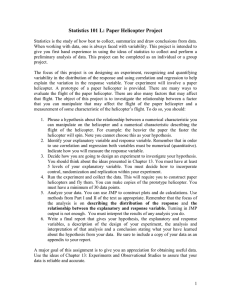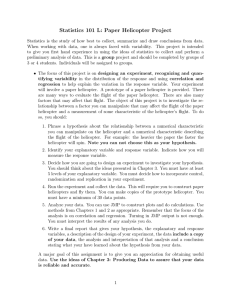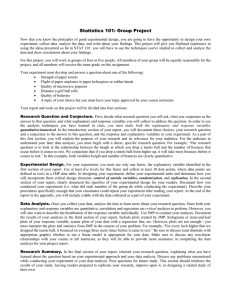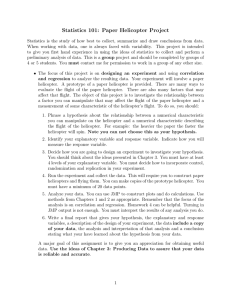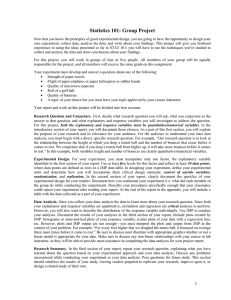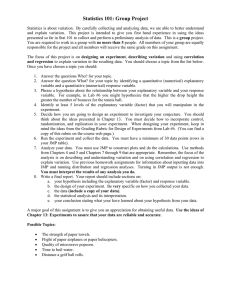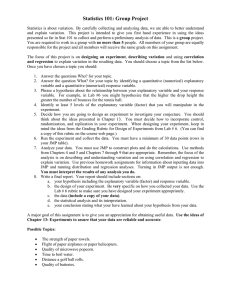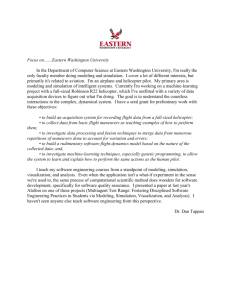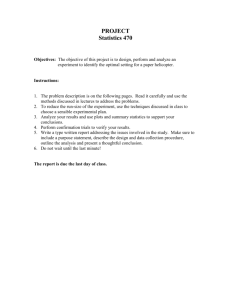Statistics 101: Paper Helicopter Project
advertisement
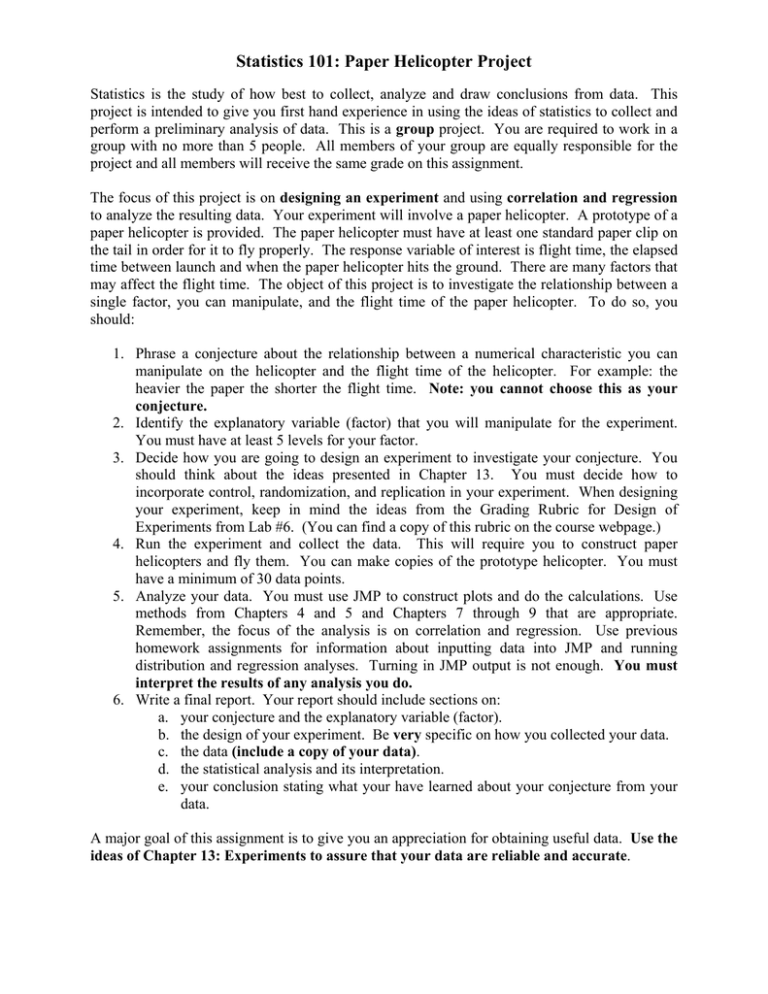
Statistics 101: Paper Helicopter Project Statistics is the study of how best to collect, analyze and draw conclusions from data. This project is intended to give you first hand experience in using the ideas of statistics to collect and perform a preliminary analysis of data. This is a group project. You are required to work in a group with no more than 5 people. All members of your group are equally responsible for the project and all members will receive the same grade on this assignment. The focus of this project is on designing an experiment and using correlation and regression to analyze the resulting data. Your experiment will involve a paper helicopter. A prototype of a paper helicopter is provided. The paper helicopter must have at least one standard paper clip on the tail in order for it to fly properly. The response variable of interest is flight time, the elapsed time between launch and when the paper helicopter hits the ground. There are many factors that may affect the flight time. The object of this project is to investigate the relationship between a single factor, you can manipulate, and the flight time of the paper helicopter. To do so, you should: 1. Phrase a conjecture about the relationship between a numerical characteristic you can manipulate on the helicopter and the flight time of the helicopter. For example: the heavier the paper the shorter the flight time. Note: you cannot choose this as your conjecture. 2. Identify the explanatory variable (factor) that you will manipulate for the experiment. You must have at least 5 levels for your factor. 3. Decide how you are going to design an experiment to investigate your conjecture. You should think about the ideas presented in Chapter 13. You must decide how to incorporate control, randomization, and replication in your experiment. When designing your experiment, keep in mind the ideas from the Grading Rubric for Design of Experiments from Lab #6. (You can find a copy of this rubric on the course webpage.) 4. Run the experiment and collect the data. This will require you to construct paper helicopters and fly them. You can make copies of the prototype helicopter. You must have a minimum of 30 data points. 5. Analyze your data. You must use JMP to construct plots and do the calculations. Use methods from Chapters 4 and 5 and Chapters 7 through 9 that are appropriate. Remember, the focus of the analysis is on correlation and regression. Use previous homework assignments for information about inputting data into JMP and running distribution and regression analyses. Turning in JMP output is not enough. You must interpret the results of any analysis you do. 6. Write a final report. Your report should include sections on: a. your conjecture and the explanatory variable (factor). b. the design of your experiment. Be very specific on how you collected your data. c. the data (include a copy of your data). d. the statistical analysis and its interpretation. e. your conclusion stating what your have learned about your conjecture from your data. A major goal of this assignment is to give you an appreciation for obtaining useful data. Use the ideas of Chapter 13: Experiments to assure that your data are reliable and accurate. Grades will be determined on: 1. How well you used the ideas of Chapter 13 to collect your data. [20 pts] 2. Relevance and completeness of the analysis of the data. [20 pts] 3. Appropriateness of your conclusions. [8 pts] 4. Clarity of the final report. [6 pts] 5. Adherence to guidelines and deadlines provided in this handout and any oral instructions given in class. [6 pts] Time table: You may submit work anytime on or before the listed dates. Submissions after the dates listed below will result in deductions from your project score. • The end of lab period the week of October 31: Groups formed. Conjecture formulated. Each group should turn in the conjecture to be investigated along with the explanatory variable (factor) that will be manipulated. • The end of lab period the week of November 14: Data collection completed. A copy of the data must be submitted and no changes to the data can be made after submission. You will NOT get this copy back so make sure you have a copy for your group. • Friday, November 18: Final report due. Submit only one report per group. Reports will NOT be returned. Each group member will receive a critique of the project and a project score. Guidelines: Work submitted for this project must follow the guidelines below. Failure to follow these guidelines will result in deductions from your project score. • • • • All work submitted for this project must include the names of all group members. Final reports must be printed using either an ink-jet or laser printer. Final reports printed on a dot-matrix printer will not be accepted. The final report must be written in the same manner as a term paper. The report should contain sections, paragraphs, complete sentences, and NO misspelled words. You should divide your report into sections, making sure to clearly label these sections. All graphs and plots must be computer generated. Hand-drawn plots or graphs will not be accepted. Use the information from previous homework assignments to create and print graphs using the computer program JMP. JMP output can be saved in a format compatible with WORD. To do this, go to the Edit → Journal menu in JMP. Save the output by going to the File → Save as menu in JMP and selecting the Save as type: RTF Files. RTF files can be opened by WORD. Additionally, you can COPY/PASTE any JMP output into WORD. 4.5 cm 4.5 cm P a p e r 8 cm H e l i c o p t e r 5 cm 10 cm 3 cm
